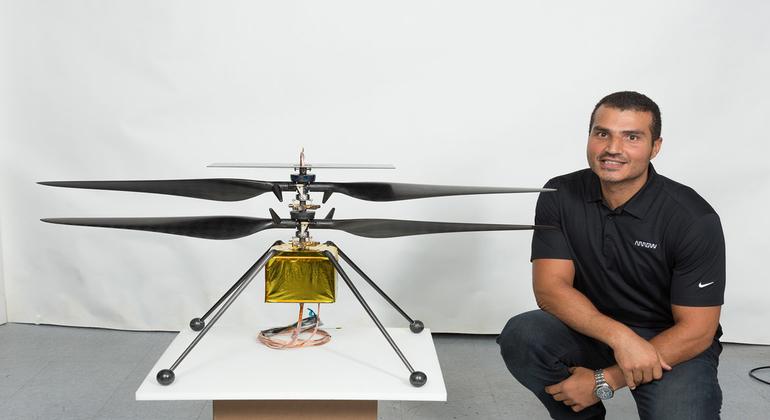
Loay Elbasyouni is a Palestinian electrical engineer on the NASA team that designed Ingenuity, an innovative robotic helicopter that landed on Mars in 2021. He talks to UN News about his journey, from a UN-run school in the Gaza strip, to the US space agency.
“I have always been passionate about the environment, and having an impact in changing our planet to a better place. I was also passionate about space, but at the same time, I really wanted to focus on making things better on our planet.
So, I worked on alternative energy and electric vehicles after college, and I learned a lot about electric motors and electric propulsion systems, and gained useful experience that I used later on in my career.
I ended up working on electric UAVs (unmanned aerial vehicles), and was selected to be the electrical lead and power electronic lead on the Ingenuity project, which I worked on for about five years.

Loay Elbasyouni
Loay Elbasyouni played a part in history with the flight of NASA’s Mars Helicopter, Ingenuity.
A groundbreaking project
Ingenuity marks the first time that we have flown on another planet. The main goal is to demonstrate the technology, to prove that we can fly on Mars, and the data we collect from the flights will help in future missions.
It’s already been almost one year since Ingenuity landed on Mars. It’s been an amazing achievement. I cannot be prouder of being part of such a team, which exceeded all expectations. We proved wrong all the people who doubted our ability to fly on Mars. It’s a great honour.
A ‘United Nations’ family
I haven’t been back to Gaza in almost 22 years. My extended family is mostly still there, but my dad got a job in Germany, and 11 years after I left I got to see them for the first time.
My brothers are scattered around the world: one is here in the US, one is in Germany and another lives in Turkey. We’re an international family, with more than five citizenships. We could call ourselves the United Nations family!
Since I was a kid, I have always had big dreams, and I have fought really hard. I had to drop out university when I first arrived in the US, because I couldn’t afford the fees, and I had to find work.

Loay Elbasyouni
Loay Elbasyouni played a part in history with the flight of NASA’s Mars Helicopter, Ingenuity.
Never give up
But I always had the passion to carry on, and be part of the solution to making the world a better place. This kept me going whenever I failed, so that I could eventually succeed.
Even when you come from challenging beginnings, you really have to believe in what you want to do and follow your dreams. When you have passion, it helps you to stay determined when you fall, because it’s not going to be easy. You will fail. You cannot give up.
This has been my approach. You just have to keep going, no matter what comes your way, you just have to try to achieve your goals.
It’s about believing in yourself: you really have to believe you can do it.”
The UN and education in Palestine
- UNRWA (the UN relief and work agency for Palestine refugees in the near east) operates 710 elementary and preparatory schools in its five fields of operation, including eight secondary schools in Lebanon, providing free basic education for some 539,000 Palestine refugee children
- UNRWA has worked for nearly 70 years to ensure that Palestine refugee children have access to quality education,
- Through its education system, UNRWA aims to ensure that Palestine refugee students develop their full potential and become “confident, innovative, questioning, thoughtful, and open-minded, to uphold human values and tolerance, proud of their Palestinian identity and contributing positively to the development of society and the global community”.
Source: Continue reading...
Upvote
0